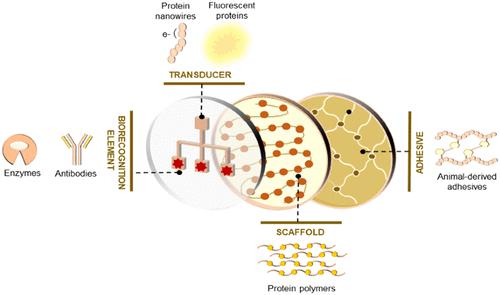当前位置:
X-MOL 学术
›
ACS Biomater. Sci. Eng.
›
论文详情
Our official English website, www.x-mol.net, welcomes your
feedback! (Note: you will need to create a separate account there.)
The Evolving Role of Proteins in Wearable Sweat Biosensors
ACS Biomaterials Science & Engineering ( IF 5.4 ) Pub Date : 2021-09-07 , DOI: 10.1021/acsbiomaterials.1c00699 Dalia Jane Saldanha 1 , Anqi Cai 1 , Noémie-Manuelle Dorval Courchesne 1
ACS Biomaterials Science & Engineering ( IF 5.4 ) Pub Date : 2021-09-07 , DOI: 10.1021/acsbiomaterials.1c00699 Dalia Jane Saldanha 1 , Anqi Cai 1 , Noémie-Manuelle Dorval Courchesne 1
Affiliation

|
Sweat is an increasingly popular biological medium for fitness monitoring and clinical diagnostics. It contains an abundance of biological information and is available continuously and noninvasively. Sweat-sensing devices often employ proteins in various capacities to create skin-friendly matrices that accurately extract valuable and time-sensitive information from sweat. Proteins were first used in sensors as biorecognition elements in the form of enzymes and antibodies, which are now being tuned to operate at ranges relevant for sweat. In addition, a range of structural proteins, sometimes assembled in conjunction with polymers, can provide flexible and compatible matrices for skin sensors. Other proteins also naturally possess a range of functionalities─as adhesives, charge conductors, fluorescence emitters, and power generators─that can make them useful components in wearable devices. Here, we examine the four main components of wearable sweat sensors─the biorecognition element, the transducer, the scaffold, and the adhesive─and the roles that proteins have played so far, or promise to play in the future, in each component. On a case-by-case basis, we analyze the performance characteristics of existing protein-based devices, their applicable ranges of detection, their transduction mechanism and their mechanical properties. Thereby, we review and compare proteins that can readily be used in sweat sensors and others that will require further efforts to overcome design, stability or scalability challenges. Incorporating proteins in one or multiple components of sweat sensors could lead to the development and deployment of tunable, greener, and safer biosourced devices.
中文翻译:

蛋白质在可穿戴汗液生物传感器中不断变化的作用
汗液是一种越来越流行的健身监测和临床诊断生物介质。它包含丰富的生物信息,并且可以连续、无创地获取。汗液传感设备通常采用各种功能的蛋白质来创建亲肤基质,从而准确地从汗液中提取有价值且对时间敏感的信息。蛋白质首先以酶和抗体的形式在传感器中用作生物识别元件,现在正在调整以在与汗液相关的范围内运行。此外,一系列结构蛋白(有时与聚合物一起组装)可以为皮肤传感器提供灵活且兼容的基质。其他蛋白质也天然地具有一系列功能,如粘合剂、电荷导体、荧光发射器和发电机,这些功能使它们成为可穿戴设备中有用的组件。在这里,我们研究了可穿戴汗液传感器的四个主要组件——生物识别元件、传感器、支架和粘合剂——以及蛋白质在每个组件中迄今为止所扮演的或未来有望扮演的角色。我们根据具体情况分析现有蛋白质器件的性能特征、检测的适用范围、转导机制和机械特性。因此,我们回顾并比较了可轻松用于汗液传感器的蛋白质和其他需要进一步努力克服设计、稳定性或可扩展性挑战的蛋白质。将蛋白质纳入汗液传感器的一个或多个组件中可能会导致可调节、更环保、更安全的生物来源设备的开发和部署。
更新日期:2021-09-07
中文翻译:

蛋白质在可穿戴汗液生物传感器中不断变化的作用
汗液是一种越来越流行的健身监测和临床诊断生物介质。它包含丰富的生物信息,并且可以连续、无创地获取。汗液传感设备通常采用各种功能的蛋白质来创建亲肤基质,从而准确地从汗液中提取有价值且对时间敏感的信息。蛋白质首先以酶和抗体的形式在传感器中用作生物识别元件,现在正在调整以在与汗液相关的范围内运行。此外,一系列结构蛋白(有时与聚合物一起组装)可以为皮肤传感器提供灵活且兼容的基质。其他蛋白质也天然地具有一系列功能,如粘合剂、电荷导体、荧光发射器和发电机,这些功能使它们成为可穿戴设备中有用的组件。在这里,我们研究了可穿戴汗液传感器的四个主要组件——生物识别元件、传感器、支架和粘合剂——以及蛋白质在每个组件中迄今为止所扮演的或未来有望扮演的角色。我们根据具体情况分析现有蛋白质器件的性能特征、检测的适用范围、转导机制和机械特性。因此,我们回顾并比较了可轻松用于汗液传感器的蛋白质和其他需要进一步努力克服设计、稳定性或可扩展性挑战的蛋白质。将蛋白质纳入汗液传感器的一个或多个组件中可能会导致可调节、更环保、更安全的生物来源设备的开发和部署。











































 京公网安备 11010802027423号
京公网安备 11010802027423号